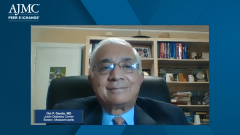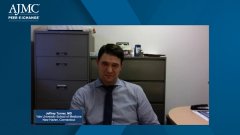
SGLT2 Inhibitors and GLP-1 Receptor Agonists in Heart Failure with Reduced and Preserved Ejection Fraction
Nihar R. Desai, MD, MPH, and Om P. Ganda, MD, discuss care pathways and the clinical utility of SGLT2 inhibitors and GLP-1 receptor agonists in heart failure.
Episodes in this series

Neil Minkoff, MD: How do you as clinicians decide when to incorporate this into a treatment pathway, and how early in the process do you incorporate it if the goal is to try to prevent the speeds downstream, downstream complications, and poor outcomes? Are you doing this right up front? Are you doing this as the patient gets more complicated? That’s one of the things that payers struggle with, understanding where it fits in terms of not just diabetes but CHF [congestive heart failure] and now metabolic syndrome.
Nihar R. Desai, MD, MPH: Getting back to something you alluded to before, I couldn’t agree more that cost is part of this, and access is an important part of the underuse of these therapies. The point you made is important and needs to be highlighted, which is that the clinical community hasn’t come together around the data. There’s a lot of clinical inertia—maybe not inertia so much as the fragmented, siloed way that our system is set up, which does a disservice to all our patients, especially the cardiorenal and cardiometabolic patient who really needs a comprehensive team mindset and team approach.
Some of that siloed and fragmented system has the cardiologists saying, “We’ll let the endocrinologist write it.” They’re going to say, “What about the nephrologist writing it? What about the primary care physician writing it?” Then nobody writes it, and the patient is left 6 months, 1 year, or 2 years down the road into their disease process. Maybe they’ve had multiple hospitalizations that could have been avoided if people came together and reimagined care in a way that delivered the best care for that patient. At Yale [School of Medicine], we’ve had a group that’s come together and been committed around how we navigate this complex path that we have to move forward with. How do you develop a care pathway for them? On the cardiovascular side for patients with heart failure, we’ve tried to come together and build consensus around our faculty to say, “Given the benefits that we’ve seen for these therapies in dedicated trials of patients with heart failure, we have to be the ones to drive that for our patients.”
Whether the patient has or doesn’t have diabetes, the benefit is quite consistent. It’s overwhelming, and it’s very early. There’s an early benefit to these therapies, and we’ve gotten into the mindset of saying, “This is in our purview, and we need to advocate for our patients and get them therapies that we think are important for their underlying disease but do that in a way that’s collaborative.” This gets the endocrinologist on board if there’s something else that needs to be changed and makes sure that our nephrology colleagues are also on board, which they very much are. That’s been a very successful pathway for us, and hopefully that means that we get these therapies to the patients who need them in a much more timely and standard fashion.
Neil Minkoff, MD: It’s pretty clear to me that earlier adoption of CHF makes sense. Most of the data to date, though, has been in reduced dejection for action. How do you look at patients with preserved ejection fraction and make that mental calculation of adding this to the regimen or not?
Nihar R. Desai, MD, MPH: For so long, we’ve had these 2 worlds of heart failure: the reduced EF [ejection fraction] and systolic heart failure. We had many trials demonstrating a benefit, as well as triple therapy and now quadruple therapy. On the preserved EF side, which is probably half the patients with heart failure, we didn’t have a lot of therapies available. We were managing their blood pressure, atrial fibrillation, and the coronary disease that were likely all contributing factors, but we never had a dedicated therapy for preserved EF heart failure. Then we had a glimmer of hope with spironolactone, and we got FDA indication for that.
Then we heard that, given the early signals with the SGLT2 inhibitors, several preserved EF heart failure clinical trials were launched. Though we haven’t seen the full data, they’ll be unveiled at the European Society of Cardiology [Congress]. We saw the top-line results from the EMPEROR-Preserved clinical trial. Empagliflozin in a large population of patients with preserved EF had met its primary end point. That’s another important sign that the SGLT2 inhibitors may also have important effects and benefits for our patients with preserved EF. As Dr Ganda mentioned earlier, that builds on what we saw in the SOLOIST-WHF program, where there seems to be a benefit among patients regardless of ejection fraction, that patients with the systolic heart failure and the diastolic or preserved EF heart failure both seem to benefit. Now we have the top-line results from EMPEROR-Preserve suggesting that we finally have evidence-based therapies for our patients with preserved EF heart failure. What a welcome change that is for all of us.
Neil Minkoff, MD: I’m going to ask a similar question to you, Dr Ganda. Approaching it from the endocrine diabetes angle, as opposed to the cardiovascular angle, how do you decide when to add diabetes therapy and then add this to diabetes therapy? What else do you consider after that, in terms of GLP1 or something like that in these patients?
Om P. Ganda, MD: To carry on with what Dr Desai was saying, this wasn’t very good news. If EMPEROR-Preserve, for example, turns out very positive in top line, yes, it is. There are more people with diabetes with preserved heart failure. Dr Desai can correct me, but this had been a block where it’s much more common in people with diabetes, yet we didn’t have any definitive therapy. In our field, I don’t mean to say that GLP1 receptor agonists should not be used first. It depends on the patient. If you look at the guidelines, including the ADA [American Diabetes Association] guidelines, if you don’t have a patient on GLP1 receptor agonists and the glucose control isn’t good, particularly in obese patients, the first thing you want to do is recommend to first line before intensifying insulin therapy, not making it much more complex on the patient. A combination of basal insulin and GLP1 receptor agonists is a great therapy for diabetes.
It depends upon the patient goal going in, but whatever the goal might be, we can simplify the regimen. In the process, we’re also getting some benefits of cardiovascular protection or maybe stroke reduction, which have been shown more conclusively with GLP1 receptor agonists thus far. We’re concerned about the high risk of cardiovascular events and heart failure. The most common risk factor for heart failure is obesity, and if you combine obesity and diabetes together, you’re in big trouble. It’s been shown in some large data analyses that for every 1% reduction in body weight—say, 2- to 3-pound weight reduction in a 200-pound person—obese people have higher, about 2% to 3% reduction in heart failure incidents prospectively. These are very important data that we need to keep in mind.
Obesity is also becoming an important factor in the progression of kidney disease, even in the onset. Years ago, it was shown that people with morbid obesity have proteinuria for no other reason. They still don’t have any drop in the eGFR [estimated glomerular filtration rate], but they have proteinuria as the first sign of kidney dysfunction. We’ll see if there are trials going on—dedicated randomized control trials in obese people with GLP1 receptor agonists, for example. For the first time, we have semaglutide in higher dosages and tirzepatide, the new GLP1 and GIP agonist, together in 1 pill. It’s not available yet, but these drugs cause amazing weight loss, almost close to what we get with bariatric surgery. Someday, we might be using these drugs in preference to sending the patient to the surgeon and increasing the cost-production rate if these trials come out to be positive. We’ll wait another few years before we can definitively say that obesity treatment will be used not only in cardiovascular disease outcomes but also in renal outcomes.
Transcript edited for clarity.
Newsletter
Stay ahead of policy, cost, and value—subscribe to AJMC for expert insights at the intersection of clinical care and health economics.





























































